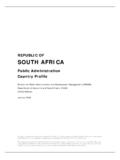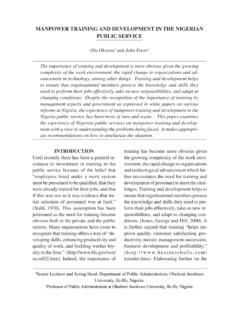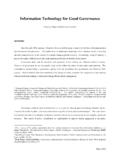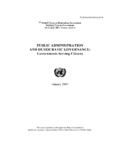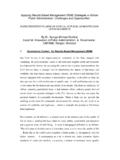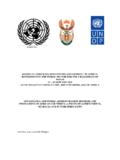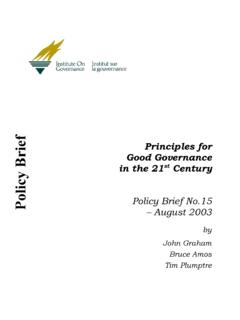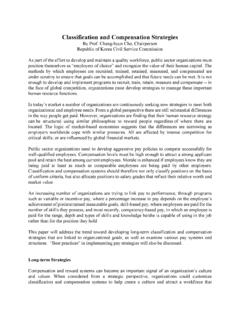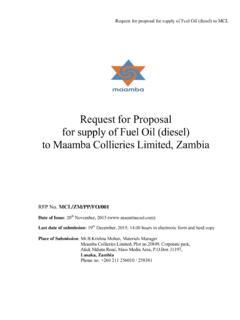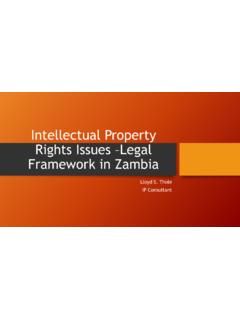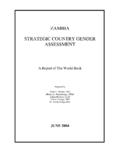Transcription of Situating Decentralization in Zambia in a Political Context
1 Situating DECENTRALISATION IN Zambia IN A Political Context BY ROYSON M. MUKWENA African Training and Research Centre in Administration for Development Centre Africain de Formation et de Recherche Administratives pour le D veloppement Situating Decentralisation in Zambia in a Political Context Dr. Royson M..MUKWENA CPST/University of Namibia 2 Introduction When decentralisation is undertaken governments usually state that the major reason for administrative reorganisation is to improve administrative performance.
2 Yet, in many cases the administrative rationale is advanced in order to cover up for unstated Political reasons behind undertaking decentralisation measures. In such situations, the unstated Political reasons are more paramount than the concerns for improving administrative performance. In this article, the author uses the Zambian experience with decentralisation to show that it is the Political Context that provides the big push for initiatives towards decentralisation. It should be emphasised here that if the Political undercurrents, which usually provide the initiatives for decentralisation programmes, are not unmasked and understood, it will be very difficult for us to appreciate and understand the factors accounting for decentralisation failures in many countries.
3 It is in this Context that the author situates decentralisation reforms in Zambia in their Political Context so as to enhance our understanding as to why some of the decentralisation measures have not lived up to their officially stated objectives. Decentralisation in Zambia Since the attainment of its independence, Zambia has initiated several decentralisation reform programmes that have entailed a mix of deconcentration, delegation and devolution. Deconcentration in Zambia has occurred through the strengthening and extension of the inherited system of field administration, whereby various central government ministries are represented in the provinces and districts by local staff.
4 Such staff are accountable to their respective district and provincial heads, who are in turn accountable to departmental or ministerial headquarters in Lusaka. Deconcentration has also occurred through the development of provincial and district government. Ideally, provincial and district government in Zambia has been maintained for the purpose of coordinating government work at district and provincial levels while also permitting the performance of responsibilities for which no special agency has existed or for which a special agency might exist but lacks local level representation by its own staff.
5 African Administrative Studies, N 57, pp.. to .. Situating Decentralisation in Zambia in a Political Context Delegation of specific functions has mainly occurred through the creation of statutory boards such as the National Housing Authority (NHA) (to provide housing); the Dairy Produce Board (DPB) (to market dairy products and promote the dairy industry); and the now defunct National Agricultural Marketing Board (NAMBOARD) (to market agricultural products and promote agriculture). The Zambian government has at times delegated certain functions to nongovernmental organisations. For example, when NAMBOARD was disbanded in 1987, the marketing of agricultural produce was delegated to the Zambia Cooperative Federation (ZCF), a nongovernmental apex organization which was created by voluntary primary (that is, local level) cooperative societies in order to coordinate and promote the activities of cooperatives in the country.
6 Situating Decentralisation in Zambia in a Political Context Dr. Royson M..MUKWENA CPST/University of Namibia 3 Devolution in Zambia has taken place through attempts to bolster the role of multipurpose local authorities governed by local councils. Membership on local councils has been through election, selection and appointment of one form or another. The various means by which Zambia has organized and re-organized its system of local authorities are discussed in Chapter Two. Before we discuss the post-independence reforms of provincial and district administration in Zambia , it is important that we describe the administrative arrangements that existed at those levels during the colonial era.
7 For administrative purposes, Northern Rhodesia was divided into eight provinces, and each of these was in turn subdivided into districts. As of 1962, Northern Rhodesia had forty-four districts. Each province was headed by a provincial commissioner. The provincial commissioner was responsible to the minister in charge of African Affairs for the good administration of his province, and for the preservation of law and order in it. He saw to it that the laws were enforced and the overall policy of the government was carried out; in addition, it was his task to plan, within the framework of general policy, the Political , economic and social development of his province.
8 This planning was performed in close connection with the district officers, and in consultation with the chiefs and native authorities and such formally constituted local authorities as may have existed in the province (Mitchell, 1963). The provincial commissioner was assisted at his provincial headquarters by administrative, technical and clerical staff. The provincial commissioner presided over a number of provincial level agencies, including the provincial team, whose duty was to put into effect plans for development. Furthermore, under various ordinances he was empowered either to appoint directly or to advise the central authorities on the appointment of members of various boards and authorities.
9 For example, under the Native Authorities Ordinance, he could appoint any African to be the native authority for an area for a period of up to six months (Mitchell, 1963). The provincial commissioner also had certain judicial powers and duties; he held a court with powers equivalent to those of a resident magistrate (Mitchell, 1963). In each district, the head of the administration was the district commissioner, who was generally the most senior district official at this level. The district commissioner was assisted by administrative staff (usually including one or more district officers, cadets, district assistants and assistant executive officers), technical staff and clerical staff.
10 The district commissioner was responsible to his provincial commissioner for the good administration of his district and for the preservation of law and order. It was his responsibility at the district level to ensure that government policies were implemented. The district commissioner also attended meetings of the native authorities in his jurisdiction in an advisory and consultative capacity. In townships where there were no management boards, the district commissioner was the local authority; and where there were management boards, he was almost invariably a board member (Mitchell, 1963, ). Further, the district commissioner was the head of the district team, which was responsible for carrying out schemes and plans for the Political , economic and social advancement of the district (Mitchell, 1963, ).
